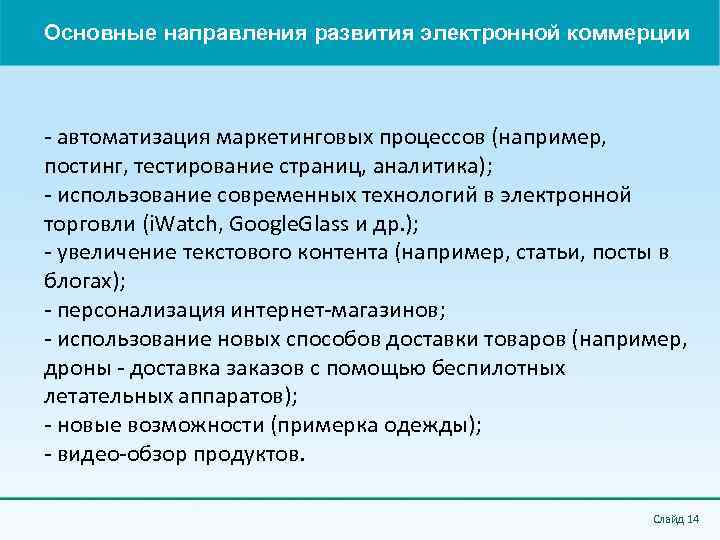Electronic business (also known as online business or e-business) is any kind of business or commercial transaction that includes sharing information across the internet. Commerce constitutes the exchange of products and services between businesses, groups, and individuals and can be seen as one of the essential activities of any business.
Electronic commerce focuses on the use of information and communication technology to enable the external activities and relationships of the business with individuals, groups, and other businesses, while e-business refers to business with help of the internet. Electronic business differs from electronic commerce as it does not only deal with online transactions of selling and buying of a product and/or service but also enables to conduct of business processes (inbound/outbound logistics, manufacturing & operations, marketing and sales, customer service) within the value chain through internal or external networks.[1] The term «e-business» was coined by IBM’s marketing and Internet team in 1996.[2][3]
Market participants in Electronic Business[edit]
Electronic business can take place between a very large number of market participants; it can be between business and consumer, private individuals, public administrations, or any other organizations such as NGOs.
These various market participants can be divided into three main groups:
1) Business (B)
2) Consumer (C)
3) Administration (A)
All of them can be either buyers or service providers within the market. There are nine possible combinations for electronic business relationships. B2C and B2B belong to E-commerce, while A2B and A2A belong to the E-government sector which is also a part of the electronic business.
Supply chain management and E-business[edit]
With the development of the e-commerce industry, business activities are becoming more and more complex to coordinate, so efficiency in business is crucial for the success of e-commerce. Hence, well-developed supply chain management is the key component of e-commerce, because the e-commerce industry is not focusing only on building an appropriate web site but it also focuses on suitable infrastructure, well-developed supply chain strategy, etc. By definition, supply chain management refers to the management of the flow of goods and services, and all activities connected with transforming the raw materials into final products. The goal of the business is to maximize customer value and gain a competitive advantage over others. The supply chain management in the e-commerce industry mainly focuses on manufacturing, supplying the raw materials, managing the supply and demand, distribution, etc. Effective supply chain management in e-commerce often gives an advantage for the companies to positively leverage new opportunities for maximizing their profit by satisfying and meeting the customer’s expectations. With the well-developed supply chain management, the company has a chance for better success by forming the right partnership and supply network, automating the business, etc.
The enabling role of e-business technologies in supply chain organizations on the development of inter organizational collaboration, and its impact on performance is discussed in depth in an article by Nada Sanders.[4]
To sum up, effective supply chain management in the e-commerce industry is needed for three main reasons:
- Ensuring high service levels and stock availability;
- Encouraging positive customer experience and reviews, and building a brand reputation;
- Cost efficiency[5][6]
History[edit]
One of the founding pillars of electronic business was the development of the Electronic Data Interchange (EDI) electronic data interchange. This system replaced traditional mailing and faxing of documents with a digital transfer of data from one computer to another, without any human intervention.
Michael Aldrich is considered the developer of the predecessor to online shopping. In 1979, the entrepreneur connected a television set to a transaction processing computer with a telephone line and called it «teleshopping», meaning shopping at distance.
From the mid-nineties, major advancements were made in the commercial use of the Internet. Amazon, which launched in 1995, started as an online bookstore and grew to become nowadays the largest online retailer worldwide, selling food, toys, electronics, apparel and more. Other successful stories of online marketplaces include eBay or Etsy.
In 1994, IBM, with its agency Ogilvy & Mather, began to use its foundation in IT solutions and expertise to market itself as a leader of conducting business on the Internet through the term «e-business.»[7] Then CEO Louis V. Gerstner, Jr. was prepared to invest $1 billion to market this new brand.[8]
After conducting worldwide market research in October 1997, IBM began with an eight-page piece in The Wall Street Journal that would introduce the concept of «e-business» and advertise IBM’s expertise in the new field.[7] IBM decided not to trademark the term «e-business» in the hopes that other companies would use the term and create an entirely new industry.[8] However, this proved to be too successful and by 2000, to differentiate itself, IBM launched a $300 million campaign about its «e-business infrastructure» capabilities.[8] Since that time, the terms, «e-business» and «e-commerce» have been loosely interchangeable and have become a part of the common vernacular.[9]
According to the U.S. Department Of Commerce, the estimated retail e-commerce sales in Q1 2020 were representing almost 12% of total U.S. retail sales, against 4% for Q1 2010.[10]
Business model[edit]
The transformation toward e-business is complex and in order for it to succeed, there is a need to balance between strategy, an adapted business model (e-intermediary, marketplaces), right processes (sales, marketing) and technology (Supply Chain Management, Customer Relationship Management).
When organizations go online, they have to decide which e-business models best suit their goals.[11] A business model is defined as the organization of product, service and information flows, and the source of revenues and benefits for suppliers and customers. The concept of the e-business model is the same but used in online presence.
Revenue model[edit]
A key component of the business model is the revenue model or profit model, which is a framework for generating revenues. It identifies which revenue source to pursue, what value to offer, how to price the value, and who pays for the value. It is a key component of a company’s business model. It primarily identifies what product or service will be created in order to generate revenues and the ways in which the product or service will be sold.
Without a well-defined revenue model, that is, a clear plan of how to generate revenues, new businesses will more likely struggle due to costs that they will not be able to sustain. By having a revenue model, a business can focus on a target audience, fund development plans for a product or service, establish marketing plans, begin a line of credit and raise capital.
E-commerce[edit]
E-commerce (short for «electronic commerce») is trading in products or services using computer networks, such as the Internet. Electronic commerce draws on technologies such as mobile commerce, electronic funds transfer, supply in chain management, Internet marketing, online transaction processing, electronic data interchange (EDI), inventory management systems, and automated data collection. Modern electronic commerce typically uses the World Wide Web for at least one part of the transaction’s life cycle, although it may also use other technologies such as e-mail.
Customer Relationship Management in e-business[edit]
Customer Relationship Management (CRM) is the strategy that is used to build relationships and interactions with customers and potential/future customers. CRM provides better customer service, allowing companies to analyze their past, current and future customers on a variety of levels. It is one of the elements which is essential for any business, including e-commerce because it allows companies to grow and succeed. It cannot be done without technology. It is the formation of bonds between customers and the company. CRM impacts e-commerce sites by becoming an essential part of business successes. Interactively collecting and considering customer data helps to build a company’s e-CRM capability, which then leads to the company’s corporate success. The goal of CRM is to establish a profitable, long-term 1-1 relationship with customers, by understanding their needs and expectations. This strategy is using 2 different approaches: software applications and software as a service.
E-commerce CRM (e-CRM) primarily focuses on customer experiences and sales that are conducted online. Most e- CRM software has the ability to analyze customer information, sales patterns, record and store data, and website’s metrics, for example:
- Conversion rates
- Customer click-through rate
- E-mail subscription opt-ins
- Which products customers are interested in
Concerns[edit]
While much has been written of the economic advantages of Internet-enabled commerce, there is also evidence that some aspects of the internet such as maps and location-aware services may serve to reinforce economic inequality and the digital divide.[12] Electronic commerce may be responsible for consolidation and the decline of mom-and-pop, brick and mortar businesses resulting in increases in income inequality.[13][14][15] Author Andrew Keen, a long-time critic of the social transformations caused by the Internet, has recently focused on the economic effects of consolidation from Internet businesses, since these businesses employ much fewer people per dollar of sales than traditional retailers.[citation needed]
Security[edit]
E-business systems naturally have greater security risks than traditional business systems, therefore it is important for e-business systems to be fully protected against these risks. A far greater number of people have access to e-businesses through the internet than would have access to a traditional business. Customers, suppliers, employees, and numerous other people use any particular e-business system daily and expect their confidential information to stay secure. Hackers are one of the great threats to the security of e-businesses. Some common security concerns for e-Businesses include keeping business and customer information private and confidential, the authenticity of data, and data integrity. Some of the methods of protecting e-business security and keeping information secure include physical security measures as well as data storage, data transmission, anti-virus software, firewalls, and encryption to list a few.[16][17]
Privacy and confidentiality[edit]
Confidentiality is the extent to which businesses makes personal information available to other businesses and individuals.[18] With any business, confidential information must remain secure and only be accessible to the intended recipient. However, this becomes even more difficult when dealing with e-businesses specifically. To keep such information secure means protecting any electronic records and files from unauthorized access, as well as ensuring safe transmission and data storage of such information. Tools such as encryption and firewalls manage this specific concern within e-business.[17]
Authenticity[edit]
E-business transactions pose greater challenges for establishing authenticity due to the ease with which electronic information may be altered and copied. Both parties in an e-business transaction want to have the assurance that the other party is who they claim to be, especially when a customer places an order and then submits a payment electronically. One common way to ensure this is to limit access to a network or trusted parties by using a virtual private network (VPN) technology. The establishment of authenticity is even greater when a combination of techniques are used, and such techniques involve checking «something you know» (i.e. password or PIN), «something you need» (i.e. credit card), or «something you are» (i.e. digital signatures or voice recognition methods). Many times in e-business, however, «something you are» is pretty strongly verified by checking the purchaser’s «something you have» (i.e. credit card) and «something you know» (i.e. card number).[17]
Data integrity[edit]
Data integrity answers the question «Can the information be changed or corrupted in any way?» This leads to the assurance that the message received is identical to the message sent. A business needs to be confident that data is not changed in transit, whether deliberately or by accident. To help with data integrity, firewalls protect stored data against unauthorized access, while simply backing up data allows recovery should the data or equipment be damaged.[17]
Non-repudiation[edit]
This concern deals with the existence of proof in a transaction. A business must have the assurance that the receiving party or purchaser cannot deny that a transaction has occurred, and this means having sufficient evidence to prove the transaction. One way to address non-repudiation is using digital signatures.[17] A digital signature not only ensures that a message or document has been electronically signed by the person, but since a digital signature can only be created by one person, it also ensures that this person cannot later deny that they provided their signature.[19]
Access control[edit]
When certain electronic resources and information is limited to only a few authorized individuals, a business and its customers must have the assurance that no one else can access the systems or information. There are a variety of techniques to address this concern including firewalls, access privileges, user identification and authentication techniques (such as passwords and digital certificates), Virtual Private Networks (VPN), and much more.[17]
Availability[edit]
This concern is specifically pertinent to a business’s customers as certain information must be available when customers need it. Messages must be delivered in a reliable and timely fashion, and information must be stored and retrieved as required. Because the availability of service is important for all e-business websites, steps must be taken to prevent disruption of service by events such as power outages and damage to physical infrastructure. Examples to address this include data backup, fire-suppression systems, Uninterrupted Power Supply (UPS) systems, virus protection, as well as making sure that there is sufficient capacity to handle the demands posed by heavy network traffic.[17]
Cost structure[edit]
The business internet which supports e-business has a cost to maintain of about $2 trillion in outsourced IT dollars just in the United States alone. With each website custom crafted and maintained in code, the maintenance burden is enormous. In the twenty-first century, look for new businesses that will help standardize the look and feel of the internet presence of a business to be more uniform in nature to help reduce the cost of maintenance.
The cost structure for e-businesses varies a lot from the industry they operate in. There are two major categories that have commune characteristics. The first group is fully digital businesses that do not provide any products or services outside of the digital world. This includes for example software companies, social networks, etc. For those, the most significant operational cost is the maintenance of the platform. Those costs are almost unrelated to every additional customer the business acquires, making the marginal cost almost equal to zero. This is one of the major advantages of that kind of business. The second group are businesses that provide services or products outside of the digital world, like online shops, for those costs are much harder to determine. Some common advantages over traditional businesses are lower marketing cost, lower inventory cost, lower payroll, lower rent, etc.[20][21]
Security solutions[edit]
When it comes to security solutions, sustainable electronic business requires support for data integrity, strong authentication, and privacy. Numerous things can be done in order to protect our E-Business. Starting off with basic things like switch to HTTPS from old outdated HTTP protocol which is more vulnerable to attacks. Furthermore, the other things that require full attention are securing servers and admin panels, payment gateway security, antivirus and anti-malware software, using firewalls is also a must, regular updates, and back up our data.
Access and data integrity[edit]
There are several different ways to prevent access to the data that is kept online. One way is to use anti-virus software. This is something that most people use to protect their networks regardless of the data they have. E-businesses should use this because they can then be sure that the information sent and received to their system is clean.[17]
A second way to protect the data is to use firewalls and network protection. A firewall is used to restrict access to private networks, as well as public networks that a company may use. The firewall also has the ability to log attempts into the network and provide warnings as it is happening. They are very beneficial to keep third parties out of the network. Businesses that use Wi-Fi need to consider different forms of protection because these networks are easier for someone to access. They should look into protected access, virtual private networks, or internet protocol security.[17]
Another option they have is an intrusion detection system. This system alerts when there are possible intrusions. Some companies set up traps or «hot spots» to attract people and are then able to know when someone is trying to hack into that area.[17]
Encryption[edit]
Encryption, which is actually a part of cryptography, involves transforming texts or messages into a code that is unreadable. These messages have to be decrypted in order to be understandable or usable for someone. There is a key that identifies the data to a certain person or company. With public-key encryption, there are actually two keys used. One is public and one is private. The public one is used for encryption and the private one for decryption. The level of the actual encryption can be adjusted and should be based on the information. The key can be just a simple slide of letters or a completely random mix-up of letters. This is relatively easy to implement because there is software that a company can purchase. A company needs to be sure that its keys are registered with a certificate authority.[17]
Digital certificates[edit]
The point of a digital certificate is to identify the owner of a document. This way the receiver knows that it is an authentic document. Companies can use these certificates in several different ways. They can be used as a replacement for user names and passwords. Each employee can be given these to access the documents that they need from wherever they are.
These certificates also use encryption. They are a little more complicated than normal encryption, however. They actually used important information within the code. They do this in order to assure the authenticity of the documents as well as confidentiality and data integrity which always accompany encryption.[17]
Digital certificates are not commonly used because they are confusing for people to implement. There can be complications when using different browsers, which means they need to use multiple certificates. The process is being adjusted so that it is easier to use.[17]
Digital signatures[edit]
A final way to secure information online would be to use a digital signature. If a document has a digital signature on it, no one else is able to edit the information without being detected. That way if it is edited, it may be adjusted for reliability after the fact. In order to use a digital signature, one must use a combination of cryptography and a message digest. A message digest is used to give the document a unique value. That value is then encrypted with the sender’s private key.[17]
Advantages and disadvantages[edit]
Advantages[edit]
When looking at e-business we have many advantages, which are mostly connected to making doing business easier. The benefits of implementing e-business tools are in the streamlining of business processes and not so much in the use of technology. Here are some:
- Easy to set up: electronic business is easy to set up even from home, the only requirements are software, a device and an internet connection.
- Flexible business hours: There are no time barriers that a location-based business can encounter since the internet is available to everyone all the time. Your products and services can be accessed by everyone with an internet connection.
- Cheaper than traditional business: Electronic business is less costly than a traditional business, but it is more expensive to set up. Transactions cost are also cheaper.
- No geographical boundaries: The greatest benefit is the possibility of geographical dispersion. Anyone can order anything from anywhere at any time.
- Government subsidies: Digitalisation is very encouraged by the government and they provide the necessary support.
- Newmarket entry: It has a great potential to enable an entry to a previously unknown market that a traditional business could not.[22][23]
- Lower levels of inventory: Electronic business enables companies to lower their level of inventory by digitalizing their assets. (i.e.: Netflix does not sell anymore physical DVDs but proposes online streaming content instead).
- Lower costs of marketing and sales: E-commerce allows the actors of the industry to advertise for their product/service offer (i.e.: house rental) at generally lower costs than by promoting physically their business.
Disadvantages[edit]
Despite all the limits, there are also some disadvantages that we need to address. The most common limitations of electronic business are:
- Lack of personal touch: The products cannot be examined or felt before the final purchase. In the traditional model, we have a more personal customer experience, while in the electronic business that is mostly not the case. Another missing factor of personal touch could also be in online transactions.
- Delivery time: Traditional business enables instant satisfaction as you obtain the product the moment you purchase it, while in electronic business that is not possible. There will always be a waiting period before you receive the product. For example, Amazon assures one-day delivery. This does not resolve the issue completely, but it is an improvement.
- Security issues: Scams could be mentioned as a factor for people’s distrust in electronic business. Hackers can easily get customers’ financial and personal details. Some customer still finds it hard to trust electronic businesses because of the lack of security, reliability and integrity issues.[22][24]
See also[edit]
- Electronic commerce
- Electronic Commerce Modeling Language
- Very Large Business Applications
- Digital economy
- Types of E-commerce
- Shopping cart software
References[edit]
- ^ Beynon-Davies P. (2004). E-Business. Palgrave, Basingstoke. ISBN 1-4039-1348-X
- ^ Gerstner, L. (2002). Who says Elephants Can’t Dance? Inside IBM’s Historic Turnaround. pg 172. ISBN 0-06-052379-4
- ^ Amor, D. (1999). The e-business (r)evolution. Upper Saddle River: Prentice Hall. ISBN 9780130851239.
- ^ Sanders, Nada R. (2007-11-01). «An empirical study of the impact of e-business technologies on organizational collaboration and performance». Journal of Operations Management. 25 (6): 1332–1347. doi:10.1016/j.jom.2007.01.008.
- ^ «Importance of Supply Chain Management in the E-commerce Industry». erpsolutionsoodles. September 25, 2019. Retrieved 5 June 2021.
- ^ Fernando, J. (5 June 2021). «Supply Chain Management (SCM): What You Need to Know». Investopedia.
- ^ a b Pettit, Raymond (2012). Learning From Winners: How the ARF Ogilvy Award Winners Use Market Research to Create Advertising Success. Taylor & Francis. pp. 32–33. ISBN 9781136676765. Retrieved 2014-05-31.
- ^ a b c Meyer, Marc H. (2007). The Fast Path to Corporate Growth: Leveraging Knowledge and Technologies to New Market Applimcations. Oxford University Press. p. 30. ISBN 978-0195180862.
- ^ Lowry, Paul Benjamin; Cherrington, J. Owen; Watson, R. J. (2001). E-Business Handbook. Boca Raton, FL: CRC Press.
- ^ «Quarterly Retail E-Commerce Sales 1st Quarter 2022» (PDF) (Press release). US Census Bureau. 19 May 2022. Retrieved 12 August 2022.
- ^ Paul Marson, (2000), Electronic Commerce — strategies & models for B2B trading, pp.31, John Wiley & Sons, Ltd, ISBN 0-471-72029-1
- ^ Badger, Emily (6 February 2013). «How the Internet Reinforces Inequality in the Real World». The Atlantic. Retrieved 2013-02-13.
- ^ «E-commerce will make the shopping mall a retail wasteland» ZDNet, January 17, 2013
- ^ «‘Free Shipping Day’ Promotion Spurs Late-Season Online Spending Surge, Improving Season-to-Date Growth Rate to 16 Percent vs. Year Ago» Comscore, December 23, 2012
- ^ «The Death of the American Shopping Mall» The Atlantic — Cities, December 26, 2012
- ^ University of Pittsburgh, comp. e-Business Resource Group Security Guidelines. Publication. 5 August 2003.
- ^ a b c d e f g h i j k l m n eCommerce theme by Potenza
- ^ Westfall, Joseph (2010). «Privacy: Electronic Information and the Individual». Santa Clara University. Markkula Center for Applied Ethics. Archived from the original on 2010-07-11. Retrieved 30 November 2010.
- ^ Awati, Rahul. «What Is Nonrepudiation? — Definition». TechTarget. Retrieved 12 August 2022.
- ^ Rodrigue, J-P. «Comparison Between Retail and E-commerce Cost Structures for a $150 Apparel Piece». The Geography of Transport Systems. Retrieved 5 June 2021.
- ^ «Using Business Model Canvas to Launch a Technology Startup or Improve Established Operating Model». Altexsoft. 27 July 2018. Retrieved 5 June 2021.
- ^ a b «Benefits and Limitations of e-Business : Dis-advantages, Solved Questions». Toppr-guides. 2018-03-10. Archived from the original on 2020-07-30. Retrieved 2020-05-29.
- ^ «Advantages Of E-Business in Today’s World | Sri Lanka Tourism Development Authority». www.sltda.lk. Retrieved 2020-05-29.
- ^ «Leaving Facebook». www.facebook.com. Retrieved 2020-05-29.
Электро́нный би́знес (англ. Electronic Business), Е-бизнес, И-бизнес, e-Business — бизнес-модель, в которой бизнес-процессы, обмен бизнес информацией и коммерческие транзакции автоматизируются с помощью информационных систем. Значительная часть решений использует Интернет-технологии для передачи данных и предоставления Web-сервисов. Впервые термин прозвучал в выступлении бывшего генерального директора IBM Луи Гёрстнера.
Электронный бизнес — совокупное понятие для множества классов ИС, автоматизирующих коммерческую работу предприятия. Помимо электронной коммерции, ориентированной на взаимодействие с потребителем в сфере продаж, осуществляется поддержка всей цепочки создания добавленной стоимости предприятия.
История
История электронного бизнеса уходит корнями в начало революции в сфере информационных технологий 1960-70х годов. Стремительное развитие ИКТ — собирательного названия отраслей микроэлектроники, компьютерной техники и телекоммуникаций — сделало возможным упростить и удешевить обмен данными между и внутри предприятий. Безбумажные технологии электронного обмена данными (EDI, далее ЭОД) начали внедрять крупные корпорации, чтобы снизить нагрузку и издержки документарной работы, а также повысить скорость обмена.
Классы промышленных систем электронного бизнеса
Существует несколько классов информационных систем, используемых предприятиями для автоматизации бизнеса:
- ERP (англ. Enterprise Resource Planning) — ИС управления ресурсами предприятия.
- CRM (англ. Customer Relationship Management) — ИС управления взаимодействием с клиентами.
- BI (англ. Business Intelligence) — ИС сбора, анализа и представления бизнес информации.
- ECM (англ. Enterprise Content Management) — ИС управления информацией и документами на предприятии.
- HRM (англ. Human Resource Management) — ИС управления персоналом.
- SCM (англ. Supply Chain Management) — ИС управления цепочками поставок.
По прогнозу IDC, общий объём рынка электронного бизнеса к 2003 году достигнет 1,6 трлн долл., причём 1,4 трлн долл. из них будут приходиться на В2В-предложения.[источник не указан 930 дней]
Согласно прогнозам eMarketer, доходы от электронного бизнеса во всем мире в 2001 году составили 336 млрд долл., в 2002 году — 686,3 млрд долл., а в 2003 году — 1,26 трлн долл.[источник не указан 930 дней]
См. также
- Электронная коммерция
- Электронная экономика
- Электронные деньги
|
|
В этой статье не хватает ссылок на источники информации.
Информация должна быть проверяема, иначе она может быть поставлена под сомнение и удалена. |
В статье приведены основные понятия электронного бизнеса и электронной коммерции…
1. Понятие электронного бизнеса
Электронный бизнес — форма ведения бизнеса, при которой значительная его часть выполняется с применением информационных технологий (локальные и глобальные сети, специализированное программное обеспечение и т.д.).
Электронный бизнес включает: продажи, маркетинг, финансовый анализ, платежи, поиск сотрудников, поддержку пользователей, поддержку партнерских отношений и др.
Части электронного бизнеса, связанные с Интернетом, включают в себя:
- Бизнес на Интернете (интернет-провайдинг, хостинг, контент-провайдинг и сервис-провайдинг).
- Бизнес вокруг Интернета (поставка технических средств, поставка программных средств, web-дизайн, программирование и сопутствующие услуги).
- Бизнес в Интернете (интернет-реклама, интернет-магазины, интернет-аукционы, интернет-расчеты, интернет-маркетинг, интернет-коммерция, информационная подписка, СМИ в Интернете).
2. Электронная коммерция как сфера сетевой экономики
Первоначально электронная коммерция («е-commerce») представляла собой форму организации продаж. Не претендуя на самостоятельность, она лишь воспроизводила методы традиционной коммерции, перенося их в среду Интернет. В последствие, электронную коммерцию стали рассматривать как сферу сетевой (электронной, цифровой, веб и др.) экономики.
Под сетевой экономикой понимается хозяйственная деятельность, осуществляемая с помощью электронных сетей (цифровых телекоммуникаций). Сетевая экономика технологически представляет собой среду, в которой юридические и физические лица могут контактировать между собой по поводу совместной деятельности.
В настоящее время существует множество определений термина «электронная коммерция». Наиболее общее определение «электронной коммерции» как сферы экономики звучит следующим образом:
«Электронная коммерция — это сфера экономики, которая включает в себя все финансовые и торговые транзакции, осуществляемые при помощи компьютерных сетей, и бизнес-процессы, связанные с проведением таких транзакций».
Электронная коммерция обеспечивает выполнение ключевых функций сетевой экономики, способствующих проведению сделок с использованием возможностей сети Интернет. В целом эти возможности сводятся к трансформации цепей поставок, информированию покупателей, а также организации приёма заказов и платежей.
Электронная коммерция состоит из шести основных элементов, обеспечивающих проведение бизнес-операций:
- Электронный обмен данными(Electronic Data Interchange, EDI) – обмен информацией с использованием цифровых средств коммуникации стандартизированными бизнес-документами (заказы и счета) между покупателями и продавцами. Основу электронного обмена данными составляют стандарты форматирования и передачи информации, разрабатываемые Международной организацией по стандартизации (ISO).
В частности, обмен данными регулируется стандартом EDIFACT (ISO 9735) – «Электронный обмен данными в управлении, торговле и на транспорте». Кроме этого, существуют региональные стандарты, например: ГОСТ 6.20.1-90 (Россия), ANSI X.12 (США). Электронный обмен данными позволяет унифицировать документооборот между торговыми партнёрами, снизить количество возможных ошибок и автоматизировать потоки информации. Стандарты EDI представляют собой перечень допустимых значений, из числа которых продавец выбирает для определенного документа (например, инвойса) необходимые элементы исходя из специфики своего бизнеса.
- Электронное движение капитала(Electronic Funds Transfer, EFS) –электронный обмен или перевод денег с одного счета на другой. В электронной коммерции EFS связано с проведением электронных денежных трансакций. Механизм EFS предполагает обмен данными между серверами, обрабатывающими денежные трансакции и связанную с ними информацию.
В качестве примера такого обмена данными можно привести систему международных межбанковских расчётов SWIFT (Society for Worldwide Interbank Financial Telecommunications). В электронной коммерции такие системы используются для осуществления не только межбанковских, но и любых иных видов платежей. Электронное движение капитала классифицируется по содержанию трансакций (дебетовые, кредитовые), по сфере их применения (например, бизнес-трансакции) или по видам операторов (банки, провайдеры). При этом операторами трансакций могут выступать и «виртуальные организации» (например, сервисы для обмена виртуальных денег).
- Электронная торговля(e-trade) – проведение торговых операций и сделок в сети Интернет, посредством которых совершается покупка (продажа) товаров, а также их оплата. Операции в электронной торговле включают в себя выбор товара, подтверждение заказа, приём платежей и обеспечение доставки.
Обычно реализация этих функций обеспечивается не непосредственно продавцами, а оказывающими посреднические услуги провайдерами. Причём оплата и доставка может быть не связана с использованием сети Интернет (например, по почте или транспортной компанией). Хотя тенденция развития электронных продаж свидетельствует о постепенном переходе к использованию возможностей Интернета на всех этап цикла продажи товара.
- Электронные деньги (e-cash) – денежные обязательства эмитента перед доверителем в электронном виде. Электронные деньги одновременно являются средством платежа и обязательством эмитента. Их преимущество заключается в скорости безналичных расчётов, а недостаток – в ограниченности сферы применения. Перевести электронные деньги в обычные можно только в рамках взаимоотношений между их владельцем и эмитентом.
Использование электронных денег в платёжных системах подразумевает наличие электронных кошельков, представляющих собой сервис онлайновых трансакций, сохраняющий платёжную информацию пользователей. Разновидностью электронных денег являются предоплаченные пластиковые карты, которые обладают всеми характеристиками пластиковых карт, но не предполагают возможности пополнения.
- Электронный маркетинг(e-marketing) – комплекс маркетинговых мероприятий, связанный с анализом рынка и продвижением товаров в сети Интернет. Обычно с электронным маркетингом связывают размещение
в сети маркетинговой информации (сайты, блоги, реклама и т.д.), а также управление размещенным контентом (веб-проектирование, веб-дизайн, веб-программирование и веб-администрирование).
Вместе с тем, если рассматривать электронный маркетинг как деятельность, связанную с продвижением товаров и услуг в сети Интернет, то здесь можно обнаружить все элементы традиционного комплекса маркетинга. Ориентированность сетевой коммерции на взаимодействие с неопределённым кругом потребителей на неопределенной территории делает электронный маркетинг незаменимым инструментом продвижения товаров в сети Интернет.
- Электронный банкинг(e-banking) – технология дистанционного банковского обслуживания, при которой доступ к счетам и операциям клиента осуществляется посредством сети Интернет. В России эта технология называется «банк-клиент» и широко применяется большинством российских банков.
Электронный банкинг включает в себя: денежные переводы, оплату товаров и услуг, проверку остатков на банковских счетах и пластиковых картах и др. На основе технологий дистанционного обслуживания через Интернет работают многие системы электронного банкинга и онлайновые биржи. Среди технических стандартов интернет-банкинга можно выделить: Open Financial Exchange (OFX), Homebanking Computer Interface (HBCI) и Bank Internet Payment System (BIPS).
3. Основные секторы коммерческого взаимодействия (модели взаимодействия)
Традиционно сферы электронной коммерции разделяют на секторы в зависимости от участников сделок и направления взаимодействия (см. рисунок 1)
Рисунок 1. 9 секторов коммерческого взаимодействия
Остановимся подробно на четырех основных секторах коммерческого взаимодействия в зависимости от участников:
- B2C(Business-to-Consumer) – вид электронной коммерции, подразумевающий осуществление сделок между юридическими и физическими лицами. Чаще всего речь идет о розничной торговле через Интернет. Это могут быть специализированные порталы продавцов, электронные торговые площадки или адресные рассылки. В результате клиенты получают возможность, не выходя из дома, выбирать и оплачивать товары на основе конкурентных предложений продавцов. Продавцы сокращают товарные запасы и ускоряют оборот, уходя от затрат на содержание торговых помещений и персонала, а также напрямую получают информацию о потребительских предпочтениях.
- B2B(Business-to-Business) – подразумевает осуществление сделок между предприятиями (юридическими лицами и предпринимателями). Технически такое взаимодействие обычно осуществляется на базе специализированных открытых интернет-платформ со стандартным набором инструментов и правил. Интерактивные базы данных позволяют не только обеспечить большой объём предложения, но и отслеживать процесс исполнения заказа. К сделкам «B2B» часто относят организацию оптовых поставок товара и размещение заказов на производственных предприятиях.
- С2С (Consumer-to-Consumer) – вид электронной коммерции, подразумевающий осуществление сделок между физическими лицами. Обычно это связано с торговлей через электронные доски объявлений ( «Avito» и др.) или на электронных торговых площадках («Meshok», «eBay», «Delcampe» и др.).
- B2G (Business-to-Government) – подразумевает осуществление сделок между экономическими субъектами (юридическими лицами) с одной стороны и государственными (муниципальными) органами управления
с другой. В широком смысле данное понятие включает в себя любые платные услуги, оказываемые экономическими субъектами государственным или муниципальным учреждениям с использованием электронного обмена данными. Примером может служить портал госзакупок РФ.
Согласно нормам действующего законодательства сделки B2G осуществляются в форме конкурсов, тендеров или котировок. В качестве преимуществ B2G можно выделить крупные размеры сделок, высокую платёжеспособность покупателя и имиджевость заключаемых контрактов. Для этого вида бизнеса существуют довольно высокие входные барьеры, преодолеть которые под силу только очень крупным компаниям.
4. Жизненный цикл изделия и коммерческий цикл
Для наглядного представления основных процессов и действий, которые могут выполняться с применением информационных технологий в электронном бизнесе, рассмотрим жизненный цикл изделия и коммерческий цикл.
Жизненный цикл изделия (продукции) — временной интервал и совокупность действий, выполняемых от момента выявления потребностей в определенной продукции или услугах до момента удовлетворения этих потребностей и утилизации продукта (см. рисунок 2). Жизненный цикл изделия включает множество этапов, отображенные на рисунке 2, включая разработку товара и подготовку производства, освоение производства товара, производство, сбыт (продажи), сервисные услуги (доставка, послепродажное обслуживание, техническая, консультационная и другая поддержка), общефирменные функции (бухгалтерские учет, управление персоналом и др.)
Рисунок 2. Жизненный цикл изделия (продукта)
На рисунке 3 упрощенно представлен коммерческий цикл, включающий процесс коммерческой деятельности (розничная и оптовая торговля) от формирования идеи бизнеса до послепродажного обслуживания и поддержки.
Рисунок 3. Традиционный и «электронный» коммерческий цикл
…
Основные понятия электронного бизнеса
Литература Кобелев, О. А. Электронная коммерция: учеб. пособие / ред. : С. В. Пирогов, О. А. Кобелев. — 4 -е изд. — М. : ИТК «Дашков и К», 2015. — 684 с. Электронный бизнес: учеб. пособие/ Шиков П. А. , Коцюба И. Ю. , Чунаев А. В. – СПб. : Издательство «Инфо-да» , 2017. – 162 с. Алексунин В. А. Электронная коммерция и маркетинг в Интернете: учеб. пособие / В. А. Алексунин, В. В. Родигина. — М. : ИТК «Дашков и К», 2007. — 216 с. Слайд 2
Определение электронного бизнеса Впервые определение электронного бизнеса как «преобразование основных бизнес-процессов при помощи интернет-технологий» было дано директором компании IBM Луи Герстнером в 1997 г. В настоящее время термин электронный бизнес включает в себя не только использование интернет-технологий, а также различных информационных систем. Слайд 3
Определение электронного бизнеса Электронный бизнес – преобразование основных бизнеспроцессов предприятия при помощи информационных систем. Слайд 4
Формы организации бизнеса в Интернете Торговые площадки (Интернет-биржи, Аукционы, Каталоги товаров и услуг). Электронное управление закупками. Порталы (Корпоративные, Информационные, Коммерческие, Персональные). Организация, содержание и обслуживание общественных глобальных сетей (осуществляется операторами сетей). Финансовые услуги (Онлайновые платежные системы, Обменные пункты, Интернет-банкинг, Интернет — трейдинг). Слайд 5
Формы организации бизнеса в Интернете Интернет-магазины. Контент-проекты (Сайты с бесплатной и востребованной информацией для привлечения посетителей с целью ведения рекламного бизнеса). Информационные посредники (Каталоги, рейтинги, поисковые системы). Информационный бизнес в Интернет (Периодические Интернет – издательства, новостные сайты и т. д. ). Интернет-маркетинг (Продвижение сайта в поисковых системах). Рекламный бизнес. Слайд 6
Формы организации бизнеса в Интернете WEB-мастеринг (создание сайтов, веб-программирование, веб-дизайн, раскрутка сайтов). MLM или сетевой маркетинг (Форма ведения внемагазинной розничной торговли). Разработка программного обеспечения, цифровых товаров и услуг. Услуги сервис-провайдеров (Поставщики сетевых услуг, поставщики хостинга, доменов). Предоставление услуг (Дистанционное обучение, сетевые библиотеки, электронное здравоохранение, Интернет — консалтинг и т. д. ); Слайд 7
Формы организации бизнеса в Интернете Игорный бизнес в сети (Виртуальные казино, Букмекерские конторы, Тотализаторы, Лотереи). Биржи труда (Агентства по трудоустройству). Партнѐрские программы. Интернет-франчайзинг. Интернет-лизинг. и др. Слайд 8
Преимущества электронного бизнеса для коммерческих организаций: — снижение затрат, связанных с продажами; — новые покупатели и увеличение прибыли; — уменьшение издержек на оплату труда; — отсутствие рисков, связанных с человеческим фактором (утечка информации, ошибки и т. д. ); — увеличение скорости выполнения транзакций; — сокращение, а в ряде моделей бизнеса и полное отсутствие материальных активов организации; — высокая скорость масштабирования бизнеса; — снижение стоимости управления заказами. Слайд 9
Электронная коммерция Определение электронный бизнес включает в себя определение электронной коммерции. Электронная коммерция – это коммерческая деятельность, в которой все финансовые и торговые транзакции осуществляются при помощи компьютерных сетей и информационных систем. Слайд 10
Электронная коммерция Первые системы и методы электронной коммерции ориентированы на автоматизацию продаж и внедрение автоматизированных систем управления корпоративными ресурсами. В 1960 американские компании American Airlines и IBM приступают к созданию системы автоматизации процедуры резервирования мест на авиарейсы. Слайд 11
Основные направления электронной коммерции интернет-магазины; интернет-страхование; интернет-банкинг; интернет-трейдинг (способ доступа к торгам на валютной, фондовой или товарной бирже с использованием интернета как средства связи); интернет-услуги (системы электронных платежей, доставка товара, консалтинговые услуги, исследовательские услуги и проч. ). Слайд 12
Основные направления развития электронной коммерции — все функции интернет-магазина должны быть доступны через мобильные устройства; — простота и безопасность мобильных платежей; — развитие геолакационной рекламы в мобильных приложениях; — оптимизация дизайна мобильных приложений для ускорения загрузки интернет-магазина на мобильном устройстве; — развитие мультиканального маркетинга и продаж через крупные площадки; — использование аналитики посещения интернет-магазина для увеличения продаж через маркетинговые акции; Слайд 13
Основные направления развития электронной коммерции — автоматизация маркетинговых процессов (например, постинг, тестирование страниц, аналитика); — использование современных технологий в электронной торговли (i. Watch, Google. Glass и др. ); — увеличение текстового контента (например, статьи, посты в блогах); — персонализация интернет-магазинов; — использование новых способов доставки товаров (например, дроны — доставка заказов с помощью беспилотных летательных аппаратов); — новые возможности (примерка одежды); — видео-обзор продуктов. Слайд 14

















